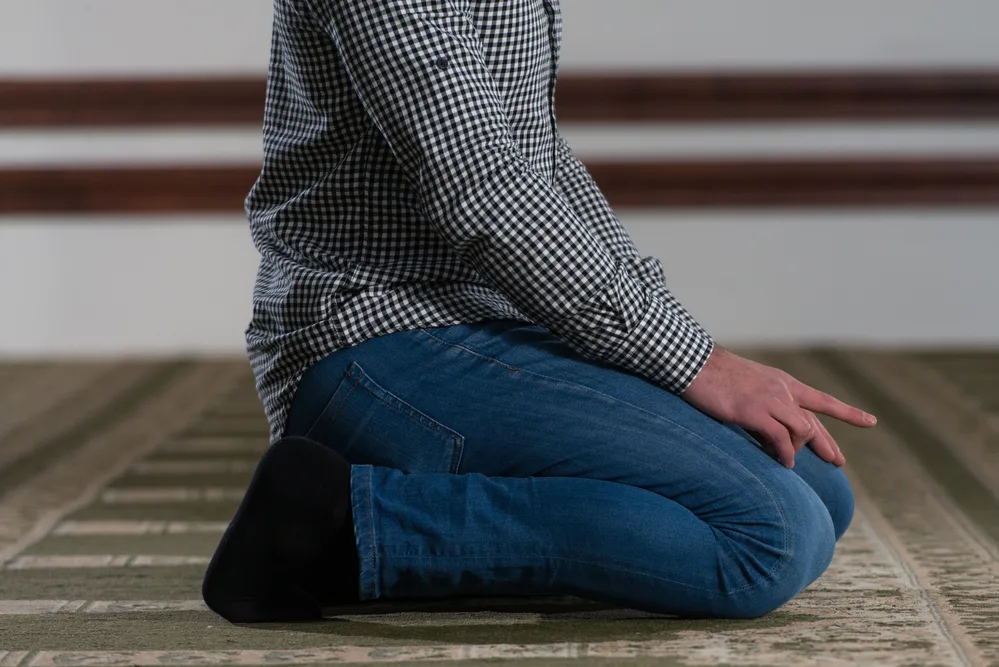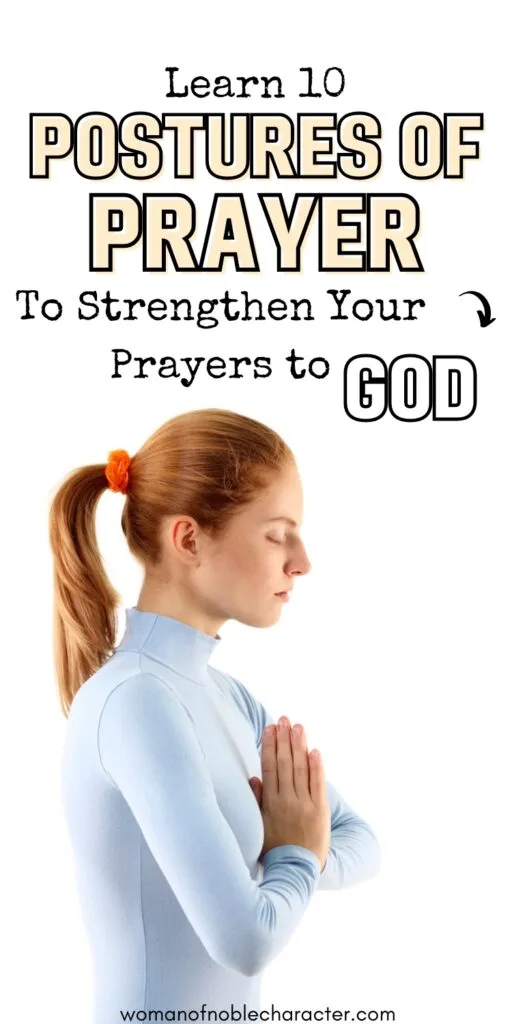This page/post may contain affiliate links. As an Amazon Associate, as well as an affiliate of other programs, this means if you purchase something using these links, I will receive a commission on qualifying purchases at no cost to you! For more detailed information, please visit our Affiliate Disclaimer page
Prayer is our lifeline as children of God and gives us direct access to his throne. Times of private prayer help us connect with the Lord and build a personal relationship with him. We know that what we pray matters but what about how we pray?
The physical body plays a part in prayer as we pray with our bodies and through them too. Postures of prayer refer to the body positions we use when talking to God. Throughout the Old Testament and New Testament, we see how the body position signified the meaning of the spoken prayer.
The posture of our bodies elevates our prayers. They help to focus and show our intentionality. Postures of prayer show our honor, respect, and reverence for the mighty God. The most important thing to remember, though, is that the posture of our hearts must be pleasing to God. We must be humble, broken before God, pure and confident that God will hear and answer our prayers.

The sacrifices of God are a broken spirit;
Psalm 51:17 ESV
a broken and contrite heart, O God, you will not despise.
As you grow in your prayer life, you’ll use different postures for different times. Prayer postures do give expression to the attitudes of our hearts. Whether we stand, sit, kneel, or lie flat out on our faces, our hearts must always be humbled in acknowledging Jesus’ lordship in our lives. At the end of the day, keep in mind that the content of our prayers is more important to God than the postures of our prayers.
10 Postures of Prayer
1. Head Bowed before God
Bowing before God is a Biblical posture that expresses worship to God. It shows our humbleness before the King of kings and Lord of lords. We see Abraham, Moses, and King David bowing before God. Even people bow before royalty and people in high positions as a sign of submission and honor.
And all the royal officials have gone to King David and congratulated him, saying, ‘May your God make Solomon’s fame even greater than your own, and may Solomon’s reign be even greater than yours!’ Then the king bowed his head in worship as he lay in his bed,
1 Kings 1:47 NLT
When Abraham’s servant heard their words, he bowed himself to the ground [in worship] before the Lord.
Genesis 24:52 AMP
Moses bowed to the earth immediately and worshiped [the Lord].
Exodus 34:8
But as for me, I will enter Your house through the abundance of Your steadfast love and tender mercy;
Psalm 5:7
At Your holy temple I will bow [obediently] in reverence for You.
you shall not bow down to their gods nor serve them, nor do as they do, but you shall utterly overthrow them and break their pillars in pieces.
Exodus 23:24
Bowing our heads is a way of submitting to God’s authority and giving him our loyalty. He doesn’t want us to bow and worship other gods but to serve and love him alone.
2. Kneeling before God
Kneeling during prayer is one of the most common prayer postures. It’s a reminder and physical demonstration of the spiritual posture of humility before God and gives him his place as the One true God and Creator of the heavens and earth. Kneeling before God provides a visual image of submission to His authority.
The form you have selected does not exist.
O come, let us worship and bow down,
Let us kneel before the Lord our Maker [in reverent praise and prayer].
When we are kneeling during prayer, it makes us focus and be intentional about what we are praying about. We are less distracted when we’re kneeling, and it shows true devotion and adoration to God. We see Daniel as a good example of someone who used this physical posture to talk to God, even at the risk of being killed for praying.
When Daniel knew that the document had been signed, he went to his house, where he had windows in his upper chamber open toward Jerusalem. He got down on his knees three times a day and prayed and gave thanks before his God, as he had done previously.
Daniel 6:10 ESV
Kneeling is a recognition of the sovereignty of God. It reflects our submission to him. The name of the Lord Jesus Christ has been exalted above every name. Even those who refuse to kneel before God will eventually kneel.
so that at the name of Jesus, every knee shall bow [in submission], of those who are in heaven and on earth and under the earth,
Philippians 2:10 AMP
Lastly, we kneel as we make supplications to God and appeal for his help. It’s a way of acknowledging that we are weak, but we have direct access to God’s strength in prayer. In ancient times, there are many biblical accounts of prayer which included bended knees. Even Christ Jesus knelt in prayer, and we can learn and practice the same too.
And so it was, when Solomon had finished praying all this prayer and supplication to the Lord, that he arose from before the altar of the Lord, from kneeling on his knees with his hands spread up to heaven.
I Kings 8:54 NKJV
And He was withdrawn from them about a stone’s throw, and He knelt down and prayed, saying, “Father, if it is Your will, take this cup away from Me; nevertheless not My will, but Yours, be done.”
Luke 22:41-42 NKJV
3. Lying Prostrate before God
We see this particular posture in the Bible being done when people were desperate for God and in impossible situations. In ancient times, it was done to offer God an urgent request. This traditional posture shows our need for God’s mercy and help. It’s a way of worshipping God while humbling ourselves to the ground where we come from and magnifying our heavenly father.

So He said, “No, but as Commander of the army of the Lord I have now come.”
Joshua 5:14 NKJV
And Joshua fell on his face to the earth and worshiped, and said to Him, “What does my Lord say to His servant?”
Then Job got up and tore his robe and shaved his head [in mourning for the children], and he fell to the ground and worshiped [God].
Job 1:20 AMP
And it happened when He was in a certain city, that behold, a man who was full of leprosy saw Jesus; and he fell on his face and implored Him, saying, “Lord, if You are willing, You can make me clean.
Luke 5:12 NKJV
Christ Jesus practiced this posture of prayer in a difficult time for him as he prayed in the Garden of Gethsemane before his crucifixion on the cross.
He went a little farther and fell on His face, and prayed, saying, “O My Father, if it is possible, let this cup pass from Me; nevertheless, not as I will, but as You will.”
Matthew 26:39 NKJV
4. Outstretched arms
Lifting our hands to God in prayer shows total, physical surrender, worship, and praise to Him. It’s a way of honoring the majesty of God and His power. It’s a petition for God’s mercy and blessing. Apostle Paul spoke of his desire to see men praying with lifted hands to God.
I desire therefore that the men pray everywhere, lifting up holy hands, without wrath and doubting;
1 Timothy 2:8 NKJV
Let my prayer be set before You as incense,
Psalm 141:2 NKJV
The lifting up of my hands as the evening sacrifice.
It’s important to note that the hands we lift to God must be clean. Holy hands hate sin and obey God’s word. They are used to serve the Lord and others.
Who may ascend the mountain of the Lord?
Psalm 24:3–4 NIV
Who may stand in his holy place?
4 The one who has clean hands and a pure heart,
who does not trust in an idol
or swear by a false god.
5. Eyes closed
We close our eyes when we pray to be able to focus and concentrate on talking to God. It helps us become less distracted too. There are times when we will open our eyes though, like when you are prayer walking or praying while driving, as it may not be safe to close your eyes then. God says we need to pray without ceasing in 1 Thessalonians 5:17, so we can pray with eyes open or shut.
6. Lifted Eyes
Lifting our eyes to the heavens shows our reliance and dependency on God. We wait on him with hope and confidence that he will answer and provide a solution in our time of need.
I lift up my eyes to the mountains—
Psalm 121:1-2 NIV
where does my help come from?
2 My help comes from the Lord,
the Maker of heaven and earth.
Christ Jesus often prayed with his eyes lifted to the heavens to show his reliance on his heavenly father. It showed the deeply personal relationship he had with God.
After saying all these things, Jesus looked up to heaven and said, “Father, the hour has come. Glorify your Son so he can give glory back to you.
John 17:1 (NLT)
Jesus occasionally connected with His Father, especially as he was about to perform a miracle. As he stood at the tomb of Lazarus, he prayed in faith to God, trusting him for the miracle that was about to happen
So they rolled the stone aside. Then Jesus looked up to heaven and said, “Father, thank you for hearing me.
John 11:41 NLT
7. Silent posture of prayer
There are specific issues that may be so painful that we don’t have the right words to utter them, so we pray a silent prayer. Hannah is a good example of this. She was barren, and her sister-wife would mock her about it. At one point, she prayed to God, and the priest thought she was drunk. It was a silent, desperate plea to God.
Now Hannah spoke in her heart; only her lips moved, but her voice was not heard. Therefore Eli thought she was drunk.
1 Samuel 1:13 (NKJV)
When awed and amazed, being silent allows us to appreciate and acknowledge God. Silent prayer also allows us to listen to him. Most times, we think prayer is about us talking to God, which makes it a one-way conversation. It’s when we are quiet that God downloads his word into our spirit.
Be still, and know that I am God;
Psalm 46:10 NKJV
I will be exalted among the nations,
I will be exalted in the earth!
8. Standing Before the Lord
When we stand before God and become still, we show that are ready to receive instruction, and to serve Him as our Heavenly Father. Standing reflects being prepared for a spiritual battle.
Therefore put on the full armor of God, so that when the day of evil comes, you may be able to stand your ground, and after you have done everything, to stand. Stand firm then, with the belt of truth buckled around your waist, with the breastplate of righteousness in place,
Ephesians 6:13–14 NIV
While standing in awe of God, the hands are usually open with the palms facing toward heaven as a way to receive from the Lord.
9. Sitting Before the Lord
Sitting as a physical posture is done to listen, pay attention, and focus on the one standing. We sit in the church, in class, and in meetings. As a prayer posture, we do it to get guidance, counsel, and instruction. It demonstrates our willingness to serve and obey God.
It’s also a posture for being calm, peaceful, and enjoying the presence of God. Seated positions are used as we rest in God, meditate on his goodness, and spend quality time with him.
Then King David went in and sat before the Lord, and he said:
2 Samuel 7:18 NIV
“Who am I, Sovereign Lord, and what is my family, that you have brought me this far?
King David sat and talked with God as a friend because of the personal relationship he had with him.
10. Loud voice and cries
Crying out to God is a desperate and urgent request for his help. Wailing in a loud voice and shrieking in pain comes from deep pain and hurt that only the Holy Spirit can heal us from. It’s an intense, heavy, and heartfelt way of bringing our needs to the throne of grace.
This poor man cried, and the Lord heard him
Psalm 34:6 (AMP)
And saved him from all his troubles.
I cried unto God with my voice, even unto God with my voice; and he gave ear unto me.
Psalm 77:1 (KJV)
In the days of his flesh, Jesus offered up prayers and supplications, with loud cries and tears, to him who was able to save him from death, and he was heard because of his reverence.
Hebrews 5:7 ESV
Even Jesus took this posture in prayer as he interceded on our behalf and prayed for himself as he went through difficult moments on earth. God heard him when he cried out, and he will hear us too.
Other postures of prayer that are mentioned in the Bible include placing the head between the knees (1 Kings 18:42), the tax collector who pounded his chest (Luke 18:13), Daniel facing Jerusalem (Daniel 6:10), and lying in the bed in prayer (Psalm 63:6). We also fold our hands in prayer and while this is not in the Bible, it’s a way of humbling ourselves before God and showing our adoration and worship to Him.
The form you have selected does not exist.
We need to be mindful of the position of our bodies in times of private prayer and public worship too.
Ultimately, your physical, outward posture should naturally reflect the spiritual, inward posture of your heart. When our hearts are attuned to God, we can pray in any of the different positions that the Holy Spirit leads us to. The most important thing to remember is not to do any prayer postures to appear holy or be seen by others but rather as a way of worshipping God as the Holy Spirit leads.
As King David said,
Let the words of my mouth, And the meditation of my heart, be acceptable in thy sight, O Lord, my strength, and my redeemer.
Psalm 19:14
You may enjoy this brief video “The Posture of Prayer” by Stephanie Ike
Or one of these recommended resources:
Spiritual On-Call: The Seven Postures of Prayer by Angela F Barnes Filzen DDS
Stretching Your Faith: Practicing Postures of Prayer to Create Peace, Balance and Freedom by Michelle Thielen
It’s All About the Posture Prayer Journal: For Women 30-40 who want to pray BOLD prayers by Shána Bernice
ESV – “Scripture quotations are from The ESV® Bible (The Holy Bible, English Standard Version®), copyright © 2001 by Crossway, a publishing ministry of Good News Publishers. Used by permission. All rights reserved.”
NKJV – Scripture taken from the New King James Version®. Copyright © 1982 by Thomas Nelson. Used by permission. All rights reserved.
NIV – Scriptures taken from the Holy Bible, New International Version®, NIV®. Copyright © 1973, 1978, 1984, 2011 by Biblica, Inc.™ Used by permission of Zondervan. All rights reserved worldwide. www.zondervan.com The “NIV” and “New International Version” are trademarks registered in the United States Patent and Trademark Office by Biblica, Inc.™
NLT – Holy Bible: New Living Translation. 1994, 2004, 2007, 2013. Carol Stream, IL: Tyndale House Publishers

